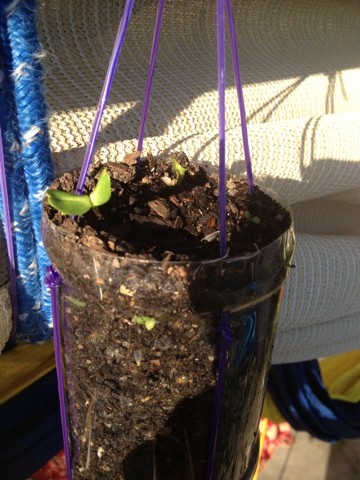 As with previous years, I planted a vegetable garden over the winter-spring cusp, in order to have a good summer crop of greens.
As with previous years, I planted a vegetable garden over the winter-spring cusp, in order to have a good summer crop of greens.Using wood I reclaimed from pallets that had been left on the road-side by a neighbor who was having some renovations done, I built this box in an afternoon, dug post holes, dropped it in place and left it lay-fallow with weed-suppressing cardboard boxes lining the base. I then filled the box 3/4 the way up with a mulch/soil mix that I had purchased (and got a water-saving rebate for), and hit our local garden/hardware store for seedlings.

In previous years I have planted in our low-sided veggie patches, but this year, as a result of my lovely partner Omega's request for a raised bed, to give better access to our crops without the need for bending and kneeling, which is one reason I built a hip-high box.
These little guys are the other reason. We now have four Flemish Giant rabbits. They started off palm sized, and will eventually get to be 10 kg (22 lb) each. I have now made two wired-off enclosures for them to run in, but we found they could both climb, and hop into the raised bed. Hence the "over the top" chicken wire over the bed, and the over-hanging lip to make a more effective perimeter fence.

A lucky finding was that the rabbits didn't like the artichoke plant that we had regrow this year from last years failed attempt. We've managed several meals worth of artichokes and Tactical Baby enjoys selecting which "dinosaur flowers" we are going to have. There are also several onion plants in there, also segregated from the bunnies, and it looks like we might have some invincible potato plants coming up as well.
I lined the side of the raised bed with a strip of copper tape, which has proven to be an effective slug and snail deterrent. We did have a cabbage moth caterpillar problem, which was attacking the broccoli, cauliflower and cabbage plants we planted, but the invading bunnies ate all the buds from them anyway, so we lost those crops.
 What we do have going however is two kinds of kale, spinach, Vietnamese mint and coriander, tomato and spring onions. We also have several eggplants on the go in there.
What we do have going however is two kinds of kale, spinach, Vietnamese mint and coriander, tomato and spring onions. We also have several eggplants on the go in there. Its a very high density plot, and it takes some rummaging to get from one plant to another, but being hip-high has been a great improvement.
My other partner Lorin has been admonishing me for planting the tomatoes in there, and not separately, because of how big they've gotten, but I'm a sucker for high density, bountiful and bodacious harvests, and that covers my gardening too!
We might even give the vertical garden another go, although we've left it a bit late in the season. Between the two extra rain barrels we put in, and the unfortunate reduction in our number of chookens (lost 7 overnight, some kind of illness, down to one, the unkillable Princess Layer, veteran of four previous calamities) we might even make more use of the back yard this summer.














